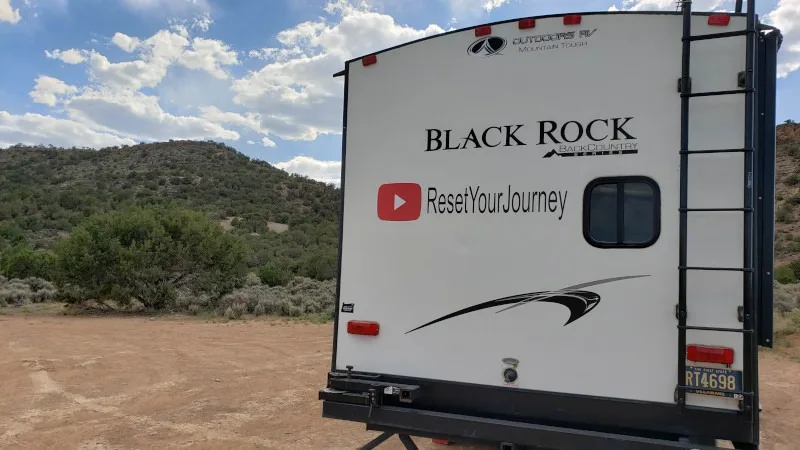Last Updated on 11/09/2023 by Glynn Willard
What features should you look for in a off-grid and off-road camper?
Before shopping for an off-grid camper, take the time to learn about what you do and don’t need.
The effort in reading this article will help eliminate the heartache of buying the wrong travel trailer or RV.
How should a boondocking RV made for the great outdoors be built (for a family)?
And I don’t mean one that costs upward of 300k plus. I’m talking about small travel trailers that are within the 32 foot range for 80-110k. Can it be done?
Only the RV manufacturers and assemblers have the answer to that question.
I present this question because we’re a family of four who has been living full-time and boondocking predominantly in our off-road camping trailer (Outdoors RV) for quite a while now.
During our time boondocking, we’ve accumulated a list of what should be changed, eliminated and considered when building an RV for fulltime living and boondocking.
In other words, a self-contained, bulletproof RV (specifically off-road trailers) built for a family.
Maybe I’m dreaming, but remember, this is a version of a “realistic” dream boondocking RV for a fulltime family.
Just because my experience is based on the best travel trailer for boondocking doesn’t mean this can’t apply to all types of RV’s.
Why Have I Zeroed In On This List?
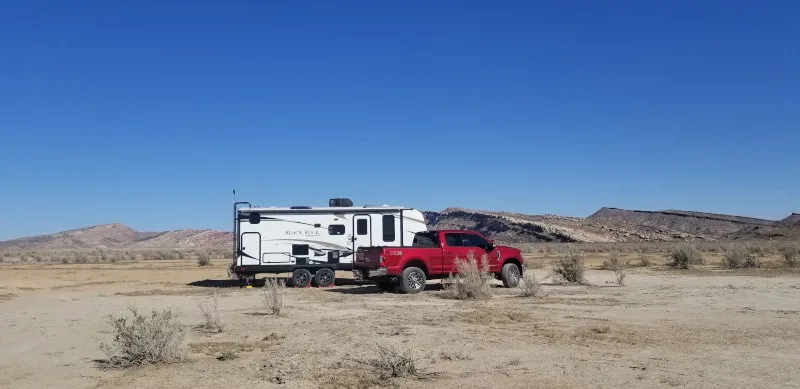
There are several variables to consider when living fulltime in RV with a family and boondocking. They are:
- There will be more weight in the small space of an RV.
- More people means more condensation.
- Boondocking means more time on rough, bumpy roads.
- Boondocking means the RV needs to be self contained for long periods of time.
- Fulltime living in an RV means the systems need to be easily accessible for regular maintenance by the owner.
What Should Be Eliminated From A Fulltime Boondocking RV?
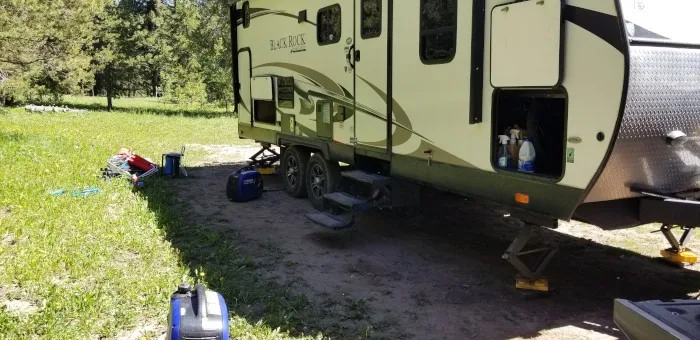
It was quiet enough at this site to do a good clean out of our storage.
Yes, to bulid the best travel trailer for boondocking or any type of RV for that matter, some things should be eliminated.
- No wood should be used in the structure or interior of the RV.
Wood is not only heavy, but it rots and is susceptible to water damage. It’s also not as structurally sound when introduced to earthquake like movements.I understand that aesthetics are important to most people and the use of an aluminum décor is cold and not as appealing, but we’re discussing what will make a long lasting safe RV for fulltime living.
- Fiberglass insulation has no place in an RV
Fiberglass harbors mold if it gets moist, which is highly likely in an RV. It also settles and shifts when moved and bumped around, which is the norm for any travel trailer on washboard dirt roads.This ultimately leads to a very low overall R factor.
- No Slides.
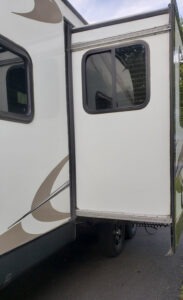
Slides are great for improving the living space in an RV, but they’re drafty and introduce the potential for mechanical problems.We typically move every four to seven days. That’s a lot of use for our slide.
I do my best with proper maintenance to make sure it stays in good working order, but eventually, it will fail in some way.
A trailer with no slide, but with a max width of 102″ can be laid out in such a way to offer plenty of living space and it’s one less mechanical system to maintain (break).
- No Outdoor Kitchen
An outdoor slide-out kitchen in a travel trailer is redundant and takes up too much of your cargo carrying capacity.It seems like it would be an excellent choice, but most people we encounter boondocking never use theirs.
- There Should Be No Decorative Skirting Or Flimsy Attributes.
There are a lot of decorative features and flashing in travel trailers that are unnecessary.They also wear quickly and easily and could be eliminated without an impact to the function of the trailer.
Again, we’re not looking for aesthetics, but rather a “bulletproof,” low-maintenance trailer.
How Should A Fulltime Boondocking RV Be Built?
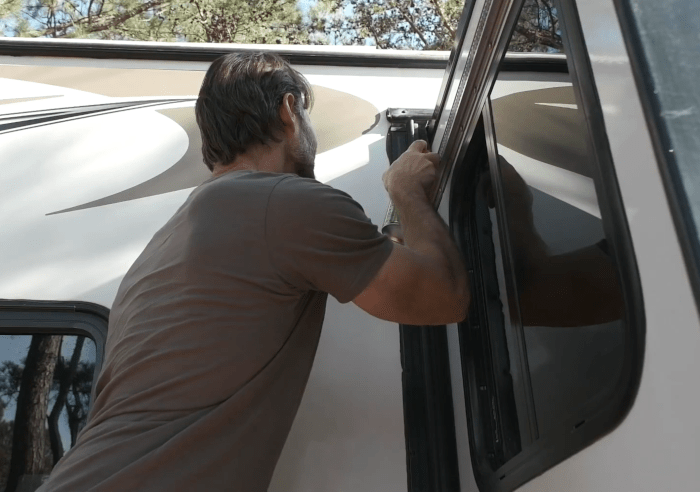
This is the most important aspect of any travel trailer.
The frame, bones, points of road contact and insulation are the first things I look for when considering a travel trailer.
It’s these factors that dictate the GVWR and CCC (cargo carrying capacity).
If you plan on living fulltime in your travel trailer, these are the most important numbers for you to keep in mind.
Below are my opinions. Some based on education and a lot based on the experience of living in an RV while boondocking most of the time.
-
All Aluminum Frame And Framing???
A steel frame is fine for most trailers, but aluminum is best for saving weight.The only downfall is its conductivity to heat. If it’s not properly insulated, it can diminish the total R-value of a floor, wall or roof.
The key here is the weight it saves, it’s structurally solid and when properly insulated will produce the best travel trailer that’s within a reasonable budget.
-
Heavy Duty Axles, Suspension And Wheels.
I believe in over-engineering the working parts of any RV.Using heavy-duty axles, a heavy-duty suspension system and wheels minimizes the overall strain on the system and increases the safety and lifespan.
There are several brands of axles and suspension equipment to choose from (and as many opinions).
My suggestion is to use equipment that’s rated for a lot more weight than the rig when fully loaded.
One can take this up a notch by shopping for a trailer with an independent suspension system.
We’re seeing more off-grid trailers with a base model offering independent suspension standard in 2023 & 2024.
-
Super Insulated On All Sides, Top And Bottom.
I realize that we really can’t use the phrase “super-insulated” and RV or travel trailer together. so instead, I should say “well-insulated.”The technology for insulating homes has come a long way, but it seems like the RV industry is far behind.
Why? Well, there’s no reason for them to catch up. Most people who buy RV’s only use them a few weeks a year.
In the defense of the industry, why use the resources and increase the cost to produce a product that no longer fits within the public’s ability to purchase?
The problem is that there is an increasing number of fulltime families.
I don’t believe this number will ever be extreme, but there is a new market for this group.
Regardless, I’ve only experienced a few custom brands of travel trailer that are actually well-insulated.
Most of them are built in the Pacific Northwest and designed for cold mountain travel.
But you have no intention of staying in a freezing environment, you say?!
The point here is that a well insulated travel trailer or so called “4 season” will minimize your use of propane or electricity for AC and stay more comfortable in any environment.
The cost difference will be negated by the fuel savings. This goes for any home including “sticks and bricks.”
I would like to see more spray foam and regular foam used and absolutely no fiberglass.
Anything that harbors mold or settles with movement has no place in an RV.
Why do I know this? I’m the son of a custom home builder whose niche was super-insulated, highly efficient homes.
One learns a lot when they grow up around and work for a person like that.
-
Four Season “Out Of The Box.”
My point here is to sell the standard model with the same amount of insulation as the premier model.In other words, insulation is not an upgrade.
-
Bolt On Underbelly Cover Allowing Easy Access To Systems.
I’m not a fan of Coroplast underbelly covers. I understand it saves weight, but it’s flimsy and makes it difficult to access the systems.I would like to see a more substantial system that has insulated latching compartment doors over every major system that might need accessing.
-
Every System Has Easy Access For Routine Maintenance.
A latching based door in front of every system that either needs maintenance or could fail. This includes any electrical components.This would make periodic maintenance and repairs a lot easier for the individual living in their RV.
Especially if they’re boondocked in the middle of nowhere. It also offers the owner an opportunity to learn more about their systems.
-
Exposed Fasteners For Easy Maintenance.
This is not inclusive of the system above for easy maintenance and repairs.Instead, I mean any screws and bolts to hold separate pieces together or attach cabinetry.
Why? It’s important to tighten all fasteners as part of your preventative maintenance.
I make a habit of doing this on a monthly basis because of the frequency of our moves.
It no longer takes a long time. My only concern is I know there are many fasteners that are not accessible (easily) I may be missing.
-
High GVWR And Cargo Capacity
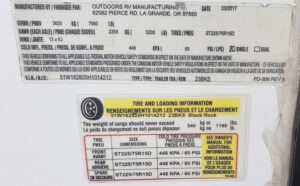
This goes back to the frame build and axle components (including the load rating on the tires).No matter what, a full time RV’er needs to be conscientious of the amount of weight they’re carrying, period.
But the objective here is to add to the safety margin.
As well as minimize wear and tear on rugged campers.
Make an effort to fully understand the GVWR and CCC of your rig.
-
High Ground Clearance
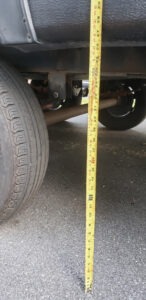
Off-road tires do not translate into an off-road travel trailer.Ground clearance and heavy-duty suspension are the important factors for off-road ability.
We go through some gnarly terrain to get to some of our boondocking locations.
If our ORV didn’t have such a high ground clearance, we’d have missed out on many of those great locations.
It’s nice to know we’re not going to damage our undercarriage due to really rough terrain.
What Should Be Included In/On A Fulltime Boondocking RV?
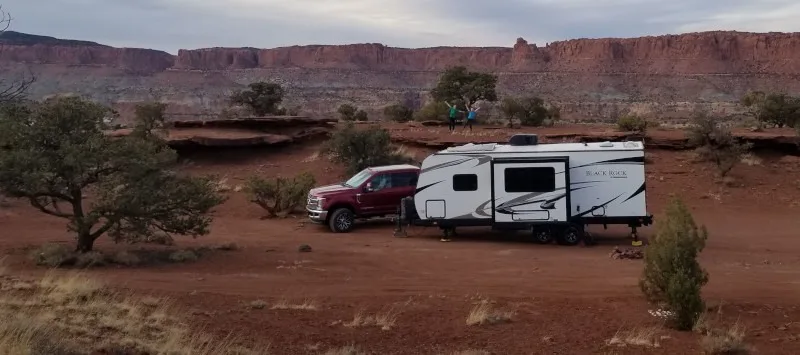
Boondocking allowed us to play on the land.
Now I get to discuss the parts that are added after the RV looks like an RV.
Ultimately, within certain parameters, every RV’er has the option to modify these aspects of the rig.
Again, based on experience, here are my suggestions to include as standard features.
-
Standard 14 Ply Tires With TPMS
It always cracks me up when the RV companies build a special edition, off road, boondocking trailer and put super grippy all terrain tires on it.Those tires are great if they’re propelling the vehicle. A trailer tire just rolls along.
So the three most important aspects are load rating, ability to prevent hydroplaning and lifespan.
No, good quality tires are not cheap, but the lifespan and safety depends on quality.
Of course, no tire is safe that’s not properly inflated. So, a TPMS should be standard on all trailers, not an upgrade.
No matter what, always learn about the proper tire inflation for the amount of weight you’re carrying.
-
Minimum Of 100 Gallon Fresh Water Tank
Water storage is the biggest limiting factor contributing to the amount of time one can stay in remote locations in an off grid trailer.This is so important that it’s mandatory in my book for a family boondocking and living in their trailer to have a large fresh water tank.
A lot of water does not exempt you from conserving and managing appropriately.
It’s heavy, but water is life. I want to get to a great spot and enjoy it for several days before having to leave due to low water.
If your water heater is a storage tank system, don’t forget to add that amount to the total.
I understand there are a lot of ways to transport water to your tank while boondocking, but you’re still at the mercy of your gray and black tank.
This leads me to the next suggestion.
-
Minimum Of 50 Gallons For Each Of The Waste Tanks.
At some point, we all have to find a dump station, but let’s delay that as long as possible.We’ve found so many ways to minimize the amount of liquid that goes into the grey water tank and black tank, buying us more time out boondocking, but we’re still at their mercy.
So, larger tanks are a must.
-
DC Refrigerator
I’m shocked more RV’s don’t make this standard equipment.They’re so efficient now that the draw is minimal on the batteries.
And if the batteries and solar are properly set up, there should never be an issue.
Save the propane for cooking! It will also diminish the necessary amount of propane onboard your rig.
All of that said, I’m seeing more off-grid camping trailers coming standard with 12 Volt DC fridges in 2023 and 2024.
-
A Large Solar Package With Lithium Cells Standard
Oh man, could I stand on my soap box now! We get so many comments that we don’t have enough solar and run our generators too much (approximately 2 hours a day under normal conditions).It’s important to understand that the battery bank and solar array would have to be enormous to run the AC for long periods of time, not to mention the additional load on the batteries.
First of all, that’s really expensive and second, it’s really heavy!
Balancing your power needs between a generator, solar and batteries is important.
So, a rig does not need a massive array, but it definitely needs something.
A battery bank of 300-400 AH lithium batteries, an inverter and enough panels to keep the batteries charged with a constant draw is good as standard equipment.
-
Aluminum Rack System With Flip Up Latches For Solar Panels
This is just a vision. I don’t even know if it exists.The point being a simple latch system the can raise and lower the panels at an angle for two reasons.
First, to make it easier to access the roof and second to angle them toward the sun depending on your geographic location.
-
Onboard Generator
It’s a lot easier and more secure to have a generator onboard than to have to remove portable units when in need.Also, if you live in your rig and boondock most of the time, you will need to change the oil frequently. It would therefore be nice if this step is easily accessible.
-
Onboard Fuel Tank For Generator
It goes without say, that if your generator is onboard, your fuel tank should be onboard.This is generally the case, so I will not spend any time on this aspect.
-
One Piece Shower Unit
We have a great boondocking rig (ORV), but it has a two piece shower/bath unit.I’m consistently cleaning grime out of the area where the two pieces meet.
I’ve experienced RV’s with a single piece shower unit and always wonder why ours doesn’t have one.
I realize, a single unit may not fit through our door, which may have been the limiting factor.
I think I have a solution for our “dream boondocking rig.”
-
Outdoor Shower
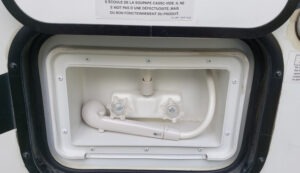
Okay, I realize most rigs have an outdoor shower, but it should be on every rig intended for boondocking.Yes, we’ve been known to take a hot shower outside a lot to save on the gray water tank space.
We also collect our shower water in the rig to douse fires along with our dishwater.
It’s surprising how nice an outdoor shower can be when you’re in a secluded boondocking location!
-
Weather Tight Wire Pass-Through For External Equipment Such As Star Link
Not everyone wants to drill holes in their roof or walls to pass wires through.Especially if it’s not something that permanently stays on the outside such as StarLink.
There is no shortage of methods to make this work with minimal impact on insulation.
The key here is to make it generic and large enough for several wires without compromising insulation.
-
Two Spare Tires
So maybe I’m asking too much, but the rig I’m imagining is dual axle, which means you could easily lose two tires on one side.And I also realize this is a space issue, but if there’s a way, you won’t regret having two.
-
Reliable And Accurate Tank Monitors
There has to be a way to engineer accurate tank monitors that are reasonably priced for RV’s that will not be affected by debris in the black and gray tank.Perhaps I have just not been exposed to all the options available.
Regardless, it seems to be such a common gripe that a solution is in order.
When boondocking for an extended time, it would really be nice to have accurate numbers for all the tanks.
-
Built In Canister Based Water Filtration System
This is more common in motorhomes and 5th wheels, but I rarely see it in travel trailers.There’s no reason not to have an inline canister based system that is easily accessible from an exterior compartment.
It could be for all water sources or just drinking water.
There are several inline options that are inexpensive as well as some that require electricity (UV and reverse osmosis), but none that are out of reach as an inline option in a travel trailer.
-
Ample Exterior Storage Space
Remember, this is supposed to be a live aboard trailer for boondocking.And with our higher than normal CCC, we’ll need to store our necessities for living as well as all our tools.
It’s important that storage is available both inside and outside the trailer.
This is of course something the consumer demands in any RV. Usually there’s more storage available than the CCC can handle anyway.
-
Standard Tank Heaters
Any trailer that’s insulated for a cold climate needs to make tank heaters a standard component of the rig.Ducting your heater ducts around the tanks is nice, but we don’t always heat with our propane.
There’s minimal draw on the batteries and it’s another layer of light weight protection against freezing tanks.
-
Manual Tongue Jack, Stabilizers And Leveling System
Now you might be scratching your head about this aspect. And I completely understand.But here’s my take on electric versus manual. Your tongue jack, leveling system and stabilizers are going to be used a lot more than average.
Electronic equipment not only has more parts that might fail, but the electronic system that makes them operate might also fail.
This is not what you need to deal with when your boondocking in a remote location.
Also, an electronic leveling system might not be enough to make up for a severely unlevel boondocking location.
Besides, once you hone your leveling skills with a shovel, Anderson levelers and blocks, you’ll be able to have your rig leveled in just a few minutes. It’s just part of boondocking.
And it will never fail mechanically!
-
Permanent Hook And Tie Downs On Walls And Floors
If there’s a hook on the wall, it will be used, period.Having a built in hook and tie-down system in the trailer would solve a lot of problems as well as eliminate the need for a lot of command hooks.
There is one toyhauler on the market I’m aware of that has such a system on the floor (ATC), but I’m not sure if they have a wall hook and mount system.
-
A Space For Each Member Of The Family: Full Size Bunk Beds
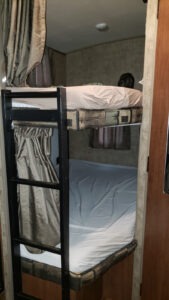 We’ve learned from fulltime boondocking that each one of us needs “our own space.” Since separate rooms are difficult to accomplish without slides, bunk beds solve this problem for the kids.
We’ve learned from fulltime boondocking that each one of us needs “our own space.” Since separate rooms are difficult to accomplish without slides, bunk beds solve this problem for the kids.And not just slender beds, but full or queen sized beds that act as a bedroom for each child.
The additional space also allows for my next point.
-
Storage Cabinets Or Shelves In The Bunk Beds.
The walls of the bunk beds should include either shelving or cabinets for the children to store their clothing and a few toys.We use soft bins that reside on the corners of the beds for the boys.
They work for now, but we and the boys often express a need for a better storage solution.
I haven’t shopped for such a feature, but again, we’re designing our perfect rig.
-
A Foot Pedal Operated Faucet For The Kitchen Sink.
I know this feature exists as an option in residential plumbing (although rare) and it was in many of the labs at the university I attended.The value of a foot pedal operated faucet comes down to water savings when washing dishes and hands.
It’s an easy addition to any plumbing line, but would rely on a little engineering for pedal placement.
Regardless, it would be an awesome feature!
-
A Well Insulated Rear Bay Door Even If It’s Not A Toyhauler.
I realize this is a tall order, but hear me out.The two most obvious benefits are:
- It would make loading and unloading the RV a lot easier. This especially applies if furniture or appliances need to be switched out, repaired or upgraded.
- With a screen set up, it makes a wonderful elevated rear deck on the RV. What’s not to love!
-
Split Air Conditioning System
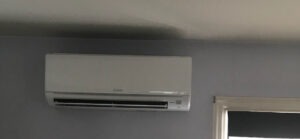
Perhaps I’ve stepped into the DeLorean and moved forward in time, but there’s a serious emergence of split AC systems in stick and brick homes.The technology has improved and they’re a lot more efficient than standard systems.
They may not have perfected a unit yet that will easily fit an RV, but it’s in the pipeline.
What made me consider this option?
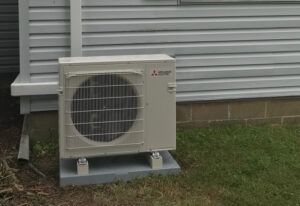
First, I’m well aware of HVAC specialists niching down to doing nothing but switching out conventional units in homes for more efficient split systems.Second, I actually met another ORV owner who installed a split system that ran entirely off his custom lithium cell and solar set up.
Yes, it required some engineering, but it worked great!
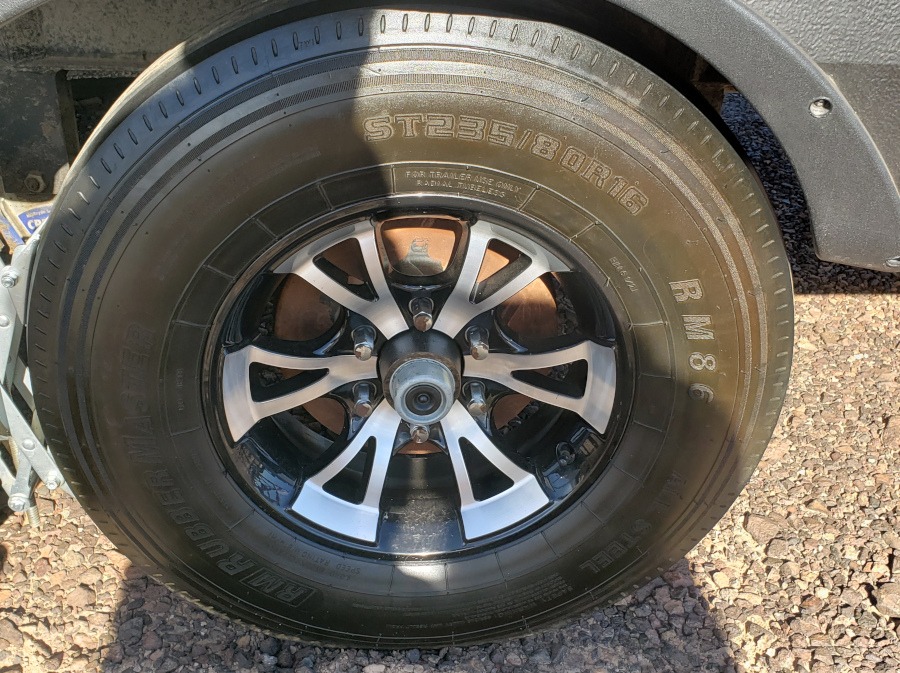
Wrapping Up The Best Travel Trailer For Boondocking (Or Any RV)

Several of our ideas are tall orders and require refinement, but none are outside the realm of achievable.
And I believe everything can be included without breaking the bank in a small camper or compromising build quality.
We all have different price point comfort levels, but remember, this is replacing a sticks and bricks home. So, it needs to be substantial.
Now, are there any RV manufacturers listening???
Frequently Asked Questions About The Best Travel Trailer For Boondocking
-
Can you boondock with a travel trailer?
Yes, travel trailers make the best boondocking RV’s that offer all the comforts of home. -
How long can you boondock in an RV?
This is largely based on the size of the fresh, gray and black tanks. We go in with 105 gallons of water and can last 9-10 days when being conservative. Not too bad for a family of four. -
Where can I boondock my RV?
BLM and USFS land offers the most boondocking locations. One’s driveways is also an option for practice. You can download a guide to how we find boondocking locations here. -
How to RV boondock?
We disclose all the tools necessary to boondock in our videos Boondocking Part 1 and Boondocking part 2. -
RV boondocking with AC?
If you’re just out for an adventure, eliminating your AC is not a big deal, but when you live in your rig, it can sometimes be a necessity. Most solar and battery set ups cannot sustain the AC for long periods. This is why we run two generators in parallel to acquire 30 amps and run the AC as long as we like. -
RV boondocking for beginners
-
Best boondocking RV?
Currently on the market RV’s that do well boondocking are made by Outdoors RV, ATC and Arctic Fox.
Happy and safe travels!
We appreciate any help we can get to bring you great content. Donate or buy us a coffee on our Ko-Fi site.


